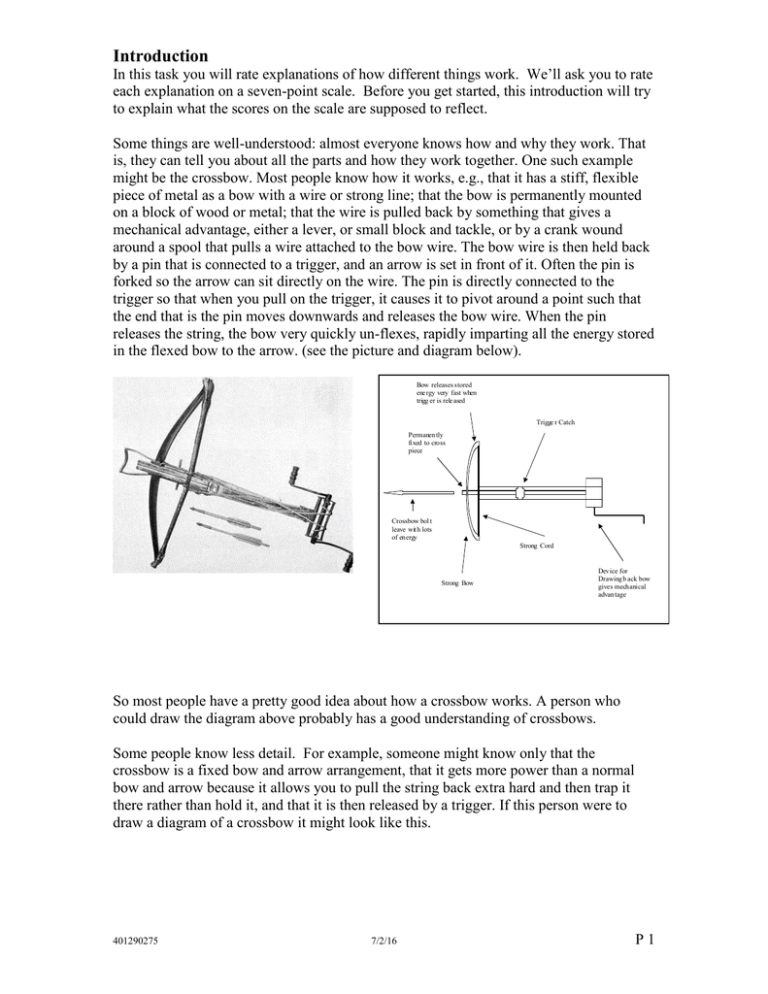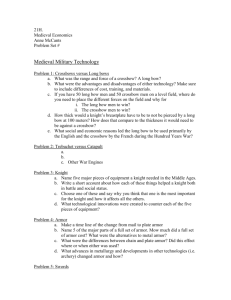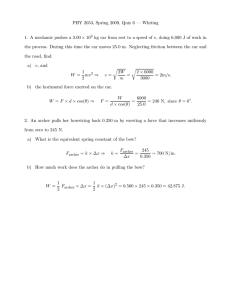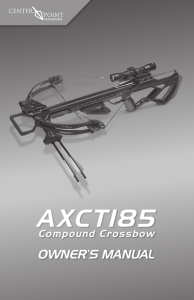Instructions used in Study 6. Except for the modified instructions, the stimuli were identical to those used in Studies 1-3.
advertisement

Introduction In this task you will rate explanations of how different things work. We’ll ask you to rate each explanation on a seven-point scale. Before you get started, this introduction will try to explain what the scores on the scale are supposed to reflect. Some things are well-understood: almost everyone knows how and why they work. That is, they can tell you about all the parts and how they work together. One such example might be the crossbow. Most people know how it works, e.g., that it has a stiff, flexible piece of metal as a bow with a wire or strong line; that the bow is permanently mounted on a block of wood or metal; that the wire is pulled back by something that gives a mechanical advantage, either a lever, or small block and tackle, or by a crank wound around a spool that pulls a wire attached to the bow wire. The bow wire is then held back by a pin that is connected to a trigger, and an arrow is set in front of it. Often the pin is forked so the arrow can sit directly on the wire. The pin is directly connected to the trigger so that when you pull on the trigger, it causes it to pivot around a point such that the end that is the pin moves downwards and releases the bow wire. When the pin releases the string, the bow very quickly un-flexes, rapidly imparting all the energy stored in the flexed bow to the arrow. (see the picture and diagram below). Bow releases stored ene rgy very fast when trigg er is rele ased Trigge r Catch Permanen tly fixed to cross piece Crossbow bol t leave wit h lots of energy Strong Cord Strong Bow Device for Drawing b ack bow gives mechanical advan tage So most people have a pretty good idea about how a crossbow works. A person who could draw the diagram above probably has a good understanding of crossbows. Some people know less detail. For example, someone might know only that the crossbow is a fixed bow and arrow arrangement, that it gets more power than a normal bow and arrow because it allows you to pull the string back extra hard and then trap it there rather than hold it, and that it is then released by a trigger. If this person were to draw a diagram of a crossbow it might look like this. 401290275 7/2/16 P1 Trigge r Catch Strong Cord Strong Bow Some people might know even less. For example, someone might really only know what a crossbow looks like and what it does -- shoots arrows. That person’s understanding might be best represented by the following diagram, where the lack of important parts and labels indicate they really don't have any idea about the details. Shoots Arrows Cord Bow What we tried to demonstrate with the crossbow example is that you can think of knowledge about how things work as arranged along a continuum, which we can represent as a seven-point scale. <1 2 3 4 5 6 7> For the crossbow, many people are probably close to a 7, such as the hypothetical person who would draw the first crossbow diagram. Others are close to a 4, such as the hypothetical person who would draw the second crossbow diagram, and some, such as a person who would draw the third crossbow diagram, are close to a 1. 401290275 7/2/16 P2 On the other hand, for something like a handheld GPS receiver, most people are probably closer to a 1, knowing only that this thing about the size of a TV remote control tells you where you are anywhere in the world with a high degree of precision. A person with level 3 knowledge might know that GPS handheld receivers get signals from satellites and that, depending on where the receiver is located on the earth, the signals from the satellites create different patterns, and some kind of computational stuff in the handheld receiver computes your position from that combined pattern. A person with level 7 knowledge of GPS receivers would know all about what those signals were, how they varied across different locations, and precisely what calculations the handheld receiver did. Level 7 knowledge would involve knowing, for example, that the signal measures distance between the receiver and the satellite (by transmitting the exact time at which the signal was sent), and that a receiver measures signals from 4 satellites to compute position. A person with level 7 knowledge would also know why the satellites need ultraaccurate clocks; why knowing the speed of light is important to being able to determine position, why you need a signal from at least three satellites to determine your position exactly, and why the radio signals must be high-frequency. Level-7 knowledge might also involve knowing something about how the entire GPS system operates, e.g., that there are many GPS satellites, monitored by multiple ground stations, and controlled by a master control station (see diagram below). Note that one does not need to be an expert to have level 7 knowledge – an intelligent, educated lay-person who has read and understood a good description of the phenomenon in an appropriate reference source probably has level 7 knowledge, as we define it. An expert in a particular phenomenon would almost necessarily have level 7 knowledge, since experts know more than even the most knowledgeable lay-people. Thus, our rating scale is not sensitive to degrees of expert knowledge – the experts know so much they are “off the scale.” The 1-7 scale we described only measures levels of non-expert knowledge. 401290275 7/2/16 P3 Instructions Part A We are going to present you with sets of explanations for 8 different items, written by other college students. We want you to rate each explanation on a 7-point scale just described. That is, you should give the explanation close to a "7" if you feel the explanation of the item is very good, and close to a "1" if you feel the explanation is very poor. A note about the explanations: we asked the explanation writers to insert the word "GAP" in their description to indicate gaps in their knowledge about a given item (that is, points at which they were uncertain how the steps in the sequence from input to output should connect). In some cases, the explanation writers felt like they didn't know anything about an item, and so left the explanation blank. Please go through explanation sets A1-A8 and rate each explanation writer’s knowledge on the 1-7 scale provided below each explanation. We have also provided a “no explanation” check-box that you can mark instead of using the 1-7 scale, if you feel that the scale is inapplicable because no explanation at all has been provided (e.g., the explanation is blank, or only says “GAP”). You will begin on “the launch-pad,” which has a button for each explanation set (marked A1-A8 and B1-B8). To begin, click on explanation set A1. You will be brought to the first explanation in the set. After rating this explanation, click “next” to continue to the next explanation in the set, and so on. (If you need to go back to a previous explanation in a set for some reason you can click the “back” button, but you cannot return all the way to the launch-pad by going backwards.) When you have rated the final explanation in the set, clicking “next” will bring you back to the launch-pad, where you should select explanation set A2 to continue. After you have rated explanation set A8, please stop and read the instructions for the second half of the task. Part B In part B, you will be provided with explanations of each phenomenon written by an expert. Let's assume that the expert explanations and the diagrams represent level-7 knowledge. After reading each expert explanation carefully, please go through explanation sets B1-B8 (which are the same explanations you saw in A1-A8), and re-rate each explanation set, this time using the expert explanation as the standard for level-7 knowledge. Starting on “the launch-pad,” click on explanation set B1. You will be brought to an expert explanation of the phenomenon described in set B1. When you have read the expert explanation carefully and feel you understand it thoroughly, click 'continue.' Clicking “continue” will take you to the first explanation in set B1. Proceed as you did in Part A. Note: if you need to go back to look at the expert rating for a particular set again, you can do so by clicking the “back” button repeatedly. You can then return to where you left off by clicking “continue” and then clicking the “next” button repeatedly until you get to the first un-rated explanation. 401290275 7/2/16 P4




